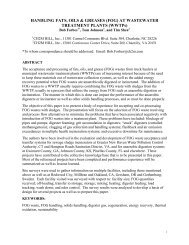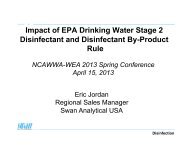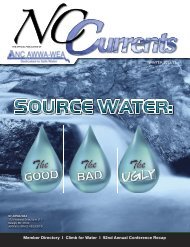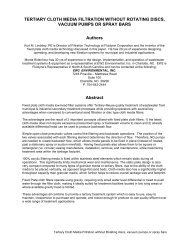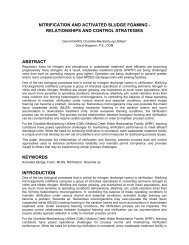TABLE 1. SPECIFIC GRAVITY OF LIKELY CONSTITUENTS OF <strong>GRIT</strong> (Reade Advanced Materials,2010)Specific Gravity of Various MaterialsQuartz Sand 1.2 Earth 1.4Limestone 1.55 Granite 1.65Clay 1.8 Red Brick 1.9Sand, wet 1.92 Gravel 2Asphalt 2.2 Concrete 2.4There is evidence that industry acceptance of this data is growing. For example, at the East Bay MUDwastewater treatment plant in the Oakland, California area it was determined that the specific gravity oftheir influent grit ranged from 1.04-1.61 with an average of 1.35 (Borys, Gabb and Hake, 2002).Illustrating the impact of this, a 210 µm particle with a specific gravity of 2.65 would settle at 2.39 cm/s at15ºC (59ºF); whereas a 210 µm particle with a specific gravity of 1.35 would settle at a rate of 0.62 cm/sat the same temperature. The difference is significant, with the higher specific gravity particle settlingalmost four times more rapidly than the other particle. This is an important fact considering thatconventional grit collection devices predominately rely on gravity as the main acceleration force causingseparation of the solids from the liquid stream.ShapeGrit particles vary in shape, are rarely spheres and many plants have noted that much of their larger gritis flat. An angular particle will exhibit reduced settling characteristics, settling more slowly than a sphereas its drag coefficient is higher (Jimimez and Madsen, 2003). More conservative design settling rates canbetter ensure capture of such angular particles.AgglomerationWhile in the collection system, the grit particles are exposed to a variety of constituents including fats, oils& greases (FOG), soaps, scum, some chemical constituents and dissolved gasses can attach to the gritparticles and alter the particles’ settling characteristics. Such wastewater constituents can be significantlyinfluenced by the commercial and industrial influences within the collection system. Regional aspects,such as the local soils and geology, winter traction control regimes and the type and age of the collectionsystem can also impact the nature of grit.Wet WeatherDuring peak wet weather events grit volume entering the plant can be 20-40+ times higher depending onthe peak to average flow ratio, as well as the age and type of collection system (Wilson, Tchobanoglous,Griffiths, 2007). As much as 70% of the annual grit load can be received at the plant during a handful offirst flush events (Wilson, 1998). These peak grit production periods frequently overload facilities, andmust also be accounted for in the design of a grit removal system, especially in terms of grit conveyanceand transport systems.<strong>GRIT</strong> SAMPLINGGrit size distribution and settling velocity is not easy to characterize. First, there is no industry standardmethod for measuring grit. Obtaining representative and repeatable samples is difficult because grit doesnot flow evenly into the plant. It tends to travel in a higher concentration at the bottom of the channel,volume fluctuates with diurnal flow variations and grit volume significantly increases during wet weatherevents according to the energy/velocity profile in the collection system. Due to these significant variationssampling should occur over several days and ideally also include a wet weather event.Care must be taken in collecting the sample to ensure it is representative of incoming grit. Sampling froma column of flow or well mixed area ensures a representative sample is collected. A sufficient amount ofmaterial must be collected for analysis and collected grit volume should be correlated to incoming flow soan inlet concentration can be determined, indicating whether the sample is representative. Whilecollecting grit, the holding vessel must be quiescent, encourage collected grit to settle and operate with aGrit Happens – You Don’t Know What You Are Missing
low surface loading rate to ensure fine and slowly settling grit particles are retained. Once sampling iscomplete, the size distribution and effective settling velocity or effective specific gravity of the grit samplemust be determined. Both characteristics are needed in order to have accurate data upon which to base asystem design.In the absence of site specific information, it is advisable to err on the side of conservatism. In mostcases, design should be based on the smallest practicable particle size which would typically be in the75-106 µm size range. Figure 2 below shows the size distribution of grit from various plants versus thesettling velocity of the grit particles expressed in sand equivalent size or SES (Wilson, Tchobanoglous,Griffiths, 2007). SES expresses the measured grit settling velocity in terms of the size of sand spherehaving the same settling velocity. SES is a method for normalizing all factors impacting settling velocity,such as size, shape, SG and agglomeration, to a known design point. The chart below shows that 106micron is a convergent point where shifts in settling velocity, carry velocity, particle impacts, etc. mergeinto a sensible design point. Relating to Figure #1, it can be seen a 100 micron cut point targets most ofthe grit entering the plant.FIGURE 2. SIZE DISTRIBUTION VS. SETTLING VELOCITY DISTRIBUTION AT MULTIPLE WWTPSLacking an adequate grit characterization, as is always the case in new construction, a design cut point of75-106 micron will generally remove 80-90% of the grit entering the treatment plant. Certain areas of thecountry are known for fine grit or ‘sugar sand’ in these areas, or regions that contain loess, the finer cutpoint of 75 micron should be used. Most other areas of the country will achieve adequate results with a106 micron design cut point particle. Reducing the design cut point particle effectively increases thesurface loading requirement four-fold allowing sufficient settling time to remove the fine and light grit thatpreviously has been overlooked, while the larger, heavier grit, that is transported to the treatment plantduring higher flows seen during diurnal flow cycles, seasonal variations and spikes in flow from wetweather events, is easily captured.SYSTEM DESIGNSeveral factors should be considered when designing a grit removal system starting with a fullcharacterization of the endemic grit including grit concentration, size distribution and settling velocity oreffective SG. Understanding the actual characteristics of grit at a particular plant facilitates properselection of the size and type of grit removal system that is required. With good data on the endemic grit,a cost benefit analysis can be determined, evaluating grit removal efficiency as compared to cost. Wherespecific data on endemic grit is not available a design cut point in the range of 75-106 micron willGrit Happens – You Don’t Know What You Are Missing




